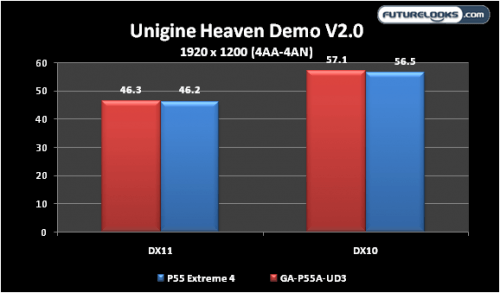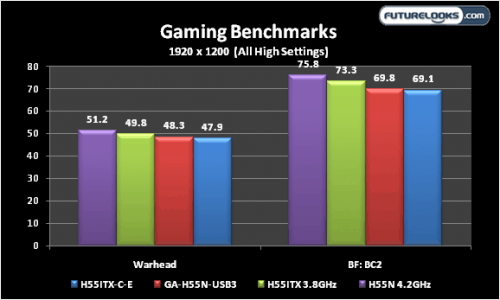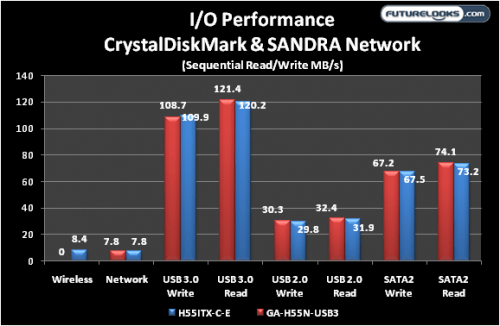Unigine Heaven Demo v2.0

Thanks to the ZOTAC Geforce GTX480, it handles the Heaven benchmark in DX10 and DX11 just fine. That means it’ll rock with video games using both DirectX versions without issue.
Games: Warhead and Bad Company 2

Yep, this thing can game! The H55N-USB3 becomes a kick a$$ gaming system when you add a performance video card. Plays movies and games just fine now with the right GPU hardware onboard.
IO Performance – CrystalDiskMark and SANDRA Network

I have to be fair here and point out that the H55N-USB3 lacks WiFi whereas the H55ITX features it. It’s always nice not having to worry about another cable when adding a home theater PC to your cinema. As you noticed, neither off these platforms support SATA3 but really don’t need it since USB 3.0 is so quick. But, it would be nice to see USB 3.0 and SATA3 as standard. In either case, both boards perform well with a bit more aggressive performance for the GIGABYTE.
RMAA Audio Performance
Since RMAA sometimes gives us mixed results when vendors try to juice it with extra special software, I opted to test with just the reference driver software. It has yet to fail reporting things like stereo cross talk and line noise that can sometimes be missed even with a good quality stereo head set. I know the Realtek ALC892 audio codec is capable of 24-bit 48Hz, 96Hz, and 192Hz. So, each setting was tested. Have a look at the results.

24-bit 48Hz RMAA Results

24-bit 96Hz ALC892 Results

24-bit 192Hz ALC892 Results
All integrated audio codecs should be more than capable of at least average 24-bit 48Hz performance. It at least achieves that. However, the integrated does better at the 96 and 192Hz settings. I’ve seen this before in other tests including the ZOTAC H55ITX-C-E which did better at 192Hz than at 48Hz. But of course more on that in a future review.
All things considered, the H55N-USB3 audio quality is noise free and clear to the plain ear. However, it’s a little flat at moderate to higher volumes. I wouldn’t expect too rich an audio experience without using the built in equalizer in the audio driver’s software. Either way, H55N has good hardware and software implementation of the integrated audio. However, if you are using the optical out to your home theatre receiver, these results no longer matter as it’s up to your own audio equipment to decode the bitstream.
